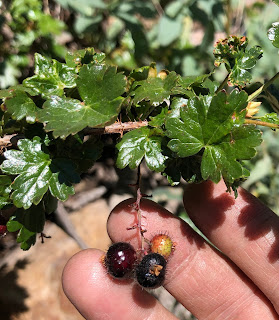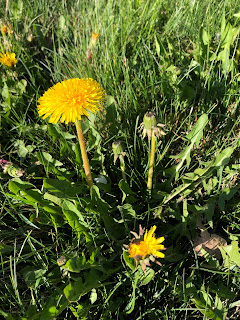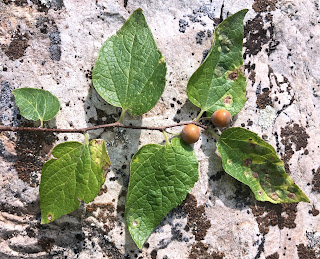 |
| Ribes lacustre |
Welcome to Mountain Edibles
I have been wandering the mountains of Utah as an amateur botanist for many years, and I am now trying to share some of what I have learned with those around me. I am a user of many edible and medicinal plants, and I believe the edible plants are the least known area of my expertise. This blog is a way to increase the popular knowledge of edible plants.
I also do plant walks to teach about edible and medicinal plants in person. If you are in the Northern Utah area, and are interested in arranging such a presentation, you can contact me using the contact form at the bottom of the page.
Thank you for coming.
Thursday, August 26, 2021
Ribes lacustre
Friday, August 6, 2021
Amaranthus retroflexus
Amaranthus retroflexus is, depending on which sources you believe, either a highly toxic plant, or a highly nutritious plant and a staple of some traditional diets. The "toxic" sources seem to prefer the common name "redroot pigweed", while the "nutritious" sources just call it amaranth. Which are you going to believe? Obviously, I'm biased towards the "nutritious" side, but it's possible that they could both be true.
I notice that most of the "toxic" sources are from agricultural sources, and report toxicity to cattle, pigs, and even goats. Amaranth is known to be able concentrate nitrates in its leaves, and in areas where there is heavy usage of chemical fertilizers which have high levels of nitrates, amaranth may have high levels of nitrates. For this reason, I would recommend against collecting your amaranth from the borders of agricultural fields. My own garden, where Amaranthus retroflexus comes up every year voluntarily, does not get these kinds of chemical fertilizers, so I'm not at risk for that type of toxicity.
Amaranth is well known for its edible seeds, which are often used similarly to grains. I have not tried collecting the seeds yet.
The leaves are commonly used as a potherb. While they can be eaten raw, I find them to be rather tough. I don't like the leaves raw much at all, but as a potherb, it is one of the best I have tasted. Boiling them for 5 minutes makes them tender, and also improves the flavor, which is like a mild spinach. Young stems (if they are still flexible) can also be eaten, and soften up nicely from the boiling. Mainly you want stems which have not formed seed clusters yet. The plants I pick often have small clusters starting to form, but I just break those off and throw them away. The small prickly bracts in those clusters do not soften when boiled, so you would want to avoid including those clusters in your pot, but if a bract or two remains from the base of the cluster, they are hardly noticeable.
Wednesday, July 28, 2021
Solanum nigrum
 |
| Solanum nigrum |
The research was rather interesting on this plant, since there is some disagreement about its edibility and/or toxicity. I found common names for it ranging from poisonberry to garden huckleberry, both of which are completely misleading. It's not poisonous, and it's not in any way related to huckleberries. Trusted first-hand accounts of eating them include Green Deane of Eat the Weeds, and Sam Thayer in his book Nature's Garden.
The main problem causing confusion seems to be that belladonna (Atropa belladonna) can be mistaken for this berry. Belladonna is also a black berry in the nightshade family and is very poisonous. The berries are larger than Black nightshade, they generally grow singly instead of in clusters, and the sepals (on a tomato, they are the green bracts at the top of the tomato where it attaches to the stem) are much larger than the berry, where as Black nightshade the sepals are quite small.
But returning to Black nightshade, the fruits themselves are quite small, like a huckleberry. They grow in clusters, though, and separate from the sepals easily. The taste is like a fruity tomato. It is sweeter than a cherry tomato, but not as sweet as a grape. It has plenty of small seeds, similar to but even smaller than tomatoes. They are not bothersome and slide down the throat easily. I enjoy the flavor a lot and would happily snack on them more often, but unfortunately they aren't found in the wild in my area. In my friend's garden, they grow quite well, and spread easily. I see them coming up in the cracks between pavers in various places in his yard.
My friend was a bit surprised when I said they were not real huckleberries. But they will continue to make pies and such things with them.
Saturday, June 12, 2021
Calochortus nuttallii
 |
| Calochortus nuttallii |
It may seem strange that I have not written about such a well-known plant before now, but Sego Lily is really a desert plant, and I spend most of my time in the mountains. Sego Lilies are very abundant during the spring in the desert valleys in this region. They are much less abundant in the mountains, but one can still find them in hot, dry areas, usually on south-facing slopes. Note that in spite of being the state flower, they are abundant, and not legally protected in any way.
I have to admit that digging the bulbs is much easier in the sandy soils of the desert, than in the rocky ground of the mountains. But fortunately, the bulbs are not the only edible part of the plant. I enjoy eating the flower buds and the seed pods, and both of these can be easily picked without killing the entire plant. The bulbs are good, but usually just too much work.
 |
| Death Camus (top) vs Sego Lily (bottom) orange coloration on sego bulb root end |
The Sego Lily bulbs, when raw, are a bit crisp, and have a bland, starchy flavor. When boiled 10 minutes, the taste is similar to when they are raw; they are softer, but still have a bit of crunchiness, and the starchy flavor is stronger. I also tried roasting the bulbs for 15 minutes. This way, they were a little dryer and slightly tough, but the roasted ones were especially good with some butter and salt. Overall, it seems the flavor is similar any way you cook them.
 |
| bulbs, cleaned bulbs, seed pods, flower buds. |
Wednesday, April 28, 2021
Taraxacum officinale
 |
| Taraxacum officinale |
The flowers, on the other hand, are much better tasting, mild and with a flavor which can almost be called slightly sweet. I used the flowers to make dandelion fritters, which are a classic way to cook dandelions. Simply dip the fresh flowers in batter, and fry in oil. Most of my family described the taste as sweet, while people at work that I shared them with called them bitter, but those people are not used to wild foods.
The flowers usually close at night, and open when the sunlight hits them in the morning. So the best time to collect the flowers is in the morning, about an hour or two after dawn, when the flowers are at their freshest and fully open. They should be used as soon as possible, since they will begin to wilt, and will even go to seed if left for a day or two.
 |
| Dandelion flower fritters |
I tried a couple different batters. One was half wheat flour and half cornmeal, with enough water to make a thin, runny batter. This resulted in a nice crunchy flower fritter. I also tried a tempura style batter, with equal parts wheat flour and cornstarch in an egg and water base. This results in a smoother fritter, crisp when fresh, but getting softer after a while, which is typical of tempura. The taste was good in both cases, but I preferred the crunchy texture of the cornmeal batter.
The unopened flower buds are also good, and make a nice vegetable to add to stir-fries and similar dishes. For this, make sure the buds are tightly closed at the end. If there is yellow or white poking out the end, they have already opened. They are more difficult to collect than the flowers, because they are small, green, and often still nestled in the base of the leaves. The bright yellow flowers stick up and are very obvious.
As I mentioned before, the leaves are plentiful, common, and easy to identify, because they usually have flowers or seed clusters above them. But they are bitter, so I don't enjoy eating them much. The white bases are a little less bitter, so you can pull up the whole plant, wash the dirt off, and just eat the white center of the leaf rosette.
Tuesday, April 6, 2021
Celtis reticulata
 |
| Celtis Reticulata |
 |
| Hackberries (closeup of split seed and fruit) |
The fresh, ripe berries are orange, round, less than a centimeter wide, and grow from the axils of the leaves. They have a large seed with a thin layer of yellow fruit. The seed has a hard brown shell, and a white kernel. At this stage they have a fresh, sweet taste which is mildly reminiscent of apricot.
The berries persist on the tree in the winter and even through the next year, so they can be a source of food in winter and in the early spring. They remain edible all winter because, as Samuel Thayer notes, they are high in sugar and low in water, and also, as noted below, the fruit flesh is resistant to bacteria and fungus infestations. The older berries have a red skin, and persist on twigs without leaves, or with leaves which are old and dry. The fruit dries to a leathery but soft texture, not hard and dry. The old berries are still edible but the taste intensifies. Others who tried it said it tasted sort of like an apricot fruit leather. I thought it tasted like honey-flavored fruit leather, just not nearly as sweet as honey.
The seed is also edible, but the hard shell can be difficult to bite into, especially in old berries. Using a mortar and pestle, two rocks, the flat of a knife, or other grinding appliance is helpful for eating the full berry. This is worth it if you are doing more than just tasting, because the kernel is high in protein and fat, even though it has little flavor. Smashing the fruit and grinding it into a paste gives you a palatable, if rather crunchy, meal.
But a better option for getting the nutrition from this hard seed is to crush it and mix it with water to make "hackberry milk", which is similar to other nut-milks, such as almond milk or cashew milk, but has its own mildly sweet flavor. For convenience, I use a blender, and blend 1 part hackberries with 4 parts water, then strain. The result is a thickish liquid (like milk) which tastes like drinking liquid hackberries.
 |
| Tree in winter, with dried leaves and fruits |

